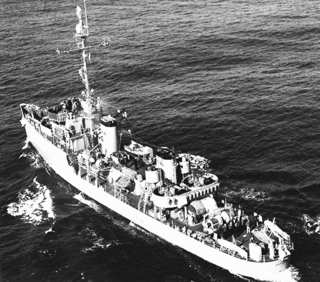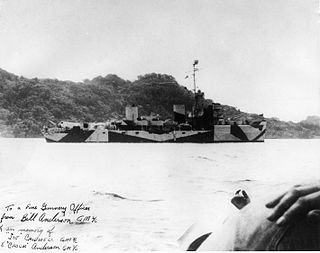
USS Devastator (AM-318) was an Auk-class minesweeper acquired by the U.S. Navy for the dangerous task of removing naval mines from minefields laid in the water to prevent ships from passing.

USS Defense (AM-317) was an Auk-class minesweeper acquired by the United States Navy for the dangerous task of removing mines from minefields laid in the water to prevent ships from passing.
USS Serene (AM-300) was an Admirable-class minesweeper built for the United States Navy during World War II. She served in the Pacific Ocean and was awarded six battle stars. She was decommissioned and placed in reserve in 1946. In January 1964, the former Serene was transferred to South Vietnam as RVNS Nhật Tảo (HQ-10) in the Republic of Vietnam Navy. She was sunk in January 1974 during combat with Chinese forces in the Battle of the Paracel Islands.

USS Shelter (AM-301) was an Admirable-class minesweeper built for the United States Navy during World War II. After service in the Pacific during World War II, Shelter was decommissioned in June 1946 and placed in reserve. In January 1964, she was transferred to South Vietnam for service in the Republic of Vietnam Navy as RVNS Chi Linh (HQ-11). She remained in South Vietnamese service until the collapse of that country in 1975. Chi Linh was one of several ships that fled from South Vietnam to the Philippines. She was then commissioned into the Philippine Navy in April 1976 as RPS Datu Tupas (PS-18), named after a chieftain of Cebu. The ship's fate is not reported in secondary sources.

USS Shoveler (AM-382) was an Auk-class minesweeper acquired by the U.S. Navy for the dangerous task of removing mines from minefields laid in the water to prevent ships from passing.

USS Starling (AM-64) was an Auk-class minesweeper acquired by the United States Navy for the dangerous task of removing mines from minefields laid in the water to prevent ships from passing.

The second USS Ardent (AM-340) was a Auk-class minesweeper in the United States Navy.

USS Velocity (AM-128) was an Auk-class minesweeper acquired by the United States Navy for the dangerous task of removing mines from minefields laid in the water to prevent ships from passing. She was the second warship to bear the name.

The third USS Champion (BAM-1/AM-314/MSF-314) was an Auk-class minesweeper of the United States Navy.
USS Tumult (AM-127) was an Auk-class minesweeper acquired by the United States Navy for the dangerous task of removing mines from minefields laid in the water to prevent ships from passing.
USS Superior (AM-311) was a steel-hulled Admirable-class minesweeper built for the U.S. Navy in 1944. Superior participated in the final struggle in the Pacific Ocean against the Empire of Japan during the end of World War II and remained behind, after the war ended, to clear minefields laid during the war.
USS Success (AM-310) was an Admirable-class minesweeper built for the United States Navy during World War II. She was awarded four battle stars for service in the Pacific during World War II. She was decommissioned in July 1946 and placed in reserve. While she remained in reserve, Success was reclassified as MSF-310 in February 1955 but never reactivated. In October 1962, she was sold to the Mexican Navy and renamed ARM DM-08. Although she is reported out of service, her ultimate fate is not reported in secondary sources.
USS Strategy (AM-308) was a steel-hulled Admirable-class minesweeper built for the U.S. Navy during World War II. She had a courageous and adventurous life in clearing minefields in areas controlled by Japanese forces. She survived attacks by Japanese gunfire and planes, and won four battle stars for her service under battle conditions.
USS Staunch (AM-307) was a steel-hulled Admirable-class minesweeper built for the U.S. Navy during World War II. Her crew was quickly trained in the art of minesweeping and then sent to the Pacific Ocean to clear dangerous mine fields so that Allied troops could land on Japanese-held beaches. Because of her courageous work under fire, she was awarded four battle stars.
USS Specter (AM-306) was an Admirable-class minesweeper built for the United States Navy during World War II. She was originally ordered, laid down, and launched as USS Spector (AM-306), but was renamed the correctly spelled Specter in March 1944. She was awarded four battle stars for service in the Pacific during World War II. She was decommissioned in 1946 and placed in reserve. While she remained in reserve, Specter was reclassified as MSF-306 in February 1955 but never reactivated. In April 1973, she was sold to the Mexican Navy and renamed ARM DM-04. In 1994 she was renamed ARM General Manuel E. Rincón (C52). She was stricken in July 2001, but her ultimate fate is not reported in secondary sources.
USS Spectacle (AM-305) was a steel-hulled Admirable class minesweeper built for the U.S. Navy during World War II. A trained crew boarded the new vessel, practiced with her minesweeping gear, and then proceeded to the Pacific Ocean to clear mines from Japanese beaches so that Allied forces could invade. While performing this dangerous task of mine clearance, a Japanese plane strafed her, and another deliberately crashed into her. When she returned to the United States, her battle damage was so severe that the U.S. Navy decided to scrap, rather than to repair, her. She was awarded two battle stars.
USS Counsel (AM-165) was an Admirable-class minesweeper built for the U.S. Navy during World War II. She was built to clear minefields in offshore waters, and served the Navy in the Pacific Ocean.
USS Rebel (AM-284) was an Admirable-class minesweeper built for the United States Navy during World War II. She was awarded four battle stars for service in the Pacific during World War II. She was decommissioned in June 1946 and placed in reserve. While she remained in reserve, Rebel was reclassified as MSF-284 in February 1955 but never reactivated. In October 1962, she was sold to the Mexican Navy and renamed ARM DM-14. In 1994 she was renamed ARM Cadete Fernando Montes de Oca (C57). She was stricken in July 2001, but her ultimate fate is not reported in secondary sources.
USS Signet (AM-302) was an Admirable-class minesweeper built for the United States Navy during World War II. She received four battle stars during World War II. She was decommissioned in December 1945 and placed in reserve. In February 1955, while still in reserve, her hull number was changed from AM-302 to MSF-302, but she was not reactivated. She was transferred to the Dominican Republic in January 1965 and renamed Tortuguero (BM455). She was employed as a patrol vessel in Dominican Navy service. Her pennant number was changed from BM455 to C455 in 1995. Tortuguero was stricken and hulked in 1997.
USS Skirmish (AM-303) was an Admirable-class minesweeper built for the United States Navy during World War II. She received four battle stars during World War II. She was decommissioned in December 1945 and placed in reserve. In February 1955, while still in reserve, her hull number was changed from AM-303 to MSF-303, but she was not reactivated. She was transferred to the Dominican Republic in January 1965 and renamed Separación (BM455). She was employed as a patrol vessel in Dominican Navy service and renamed Prestol Botello in 1976. Her pennant number was changed from BM454 to C454 during a 1995 refit. As of 2007, Prestol Botello remained in active service for the Dominican Navy.







